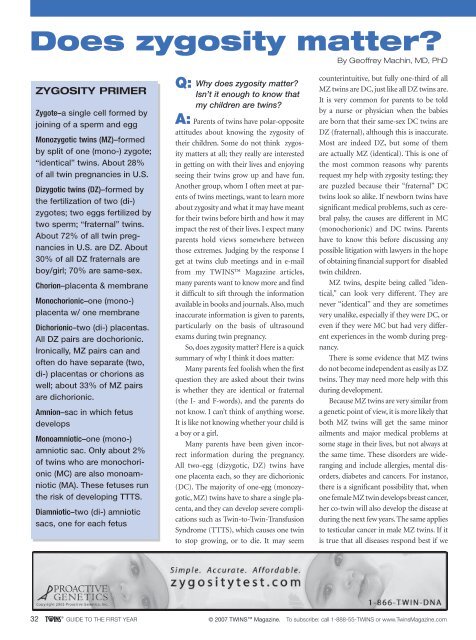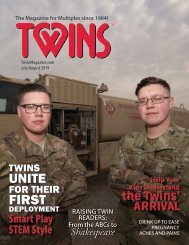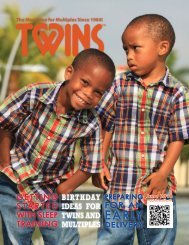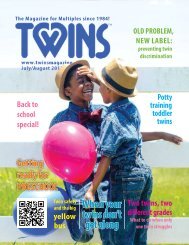2007GuideToTheFirstYear
Create successful ePaper yourself
Turn your PDF publications into a flip-book with our unique Google optimized e-Paper software.
Does zygosity matter?<br />
By Geoffrey Machin, MD, PhD<br />
ZYGOSITY PRIMER<br />
Zygote–a single cell formed by<br />
joining of a sperm and egg<br />
Monozygotic twins (MZ)–formed<br />
by split of one (mono-) zygote;<br />
“identical” twins. About 28%<br />
of all twin pregnancies in U.S.<br />
Dizygotic twins (DZ)–formed by<br />
the fertilization of two (di-)<br />
zygotes; two eggs fertilized by<br />
two sperm; “fraternal” twins.<br />
About 72% of all twin pregnancies<br />
in U.S. are DZ. About<br />
30% of all DZ fraternals are<br />
boy/girl; 70% are same-sex.<br />
Chorion–placenta & membrane<br />
Monochorionic–one (mono-)<br />
placenta w/ one membrane<br />
Dichorionic–two (di-) placentas.<br />
All DZ pairs are dochorionic.<br />
Ironically, MZ pairs can and<br />
often do have separate (two,<br />
di-) placentas or chorions as<br />
well; about 33% of MZ pairs<br />
are dichorionic.<br />
Amnion–sac in which fetus<br />
develops<br />
Monoamniotic–one (mono-)<br />
amniotic sac. Only about 2%<br />
of twins who are monochorionic<br />
(MC) are also monoamniotic<br />
(MA). These fetuses run<br />
the risk of developing TTTS.<br />
Diamniotic–two (di-) amniotic<br />
sacs, one for each fetus<br />
Q: Why does zygosity matter?<br />
Isn’t it enough to know that<br />
my children are twins?<br />
A: Parents of twins have polar-opposite<br />
attitudes about knowing the zygosity of<br />
their children. Some do not think zygosity<br />
matters at all; they really are interested<br />
in getting on with their lives and enjoying<br />
seeing their twins grow up and have fun.<br />
Another group, whom I often meet at parents<br />
of twins meetings, want to learn more<br />
about zygosity and what it may have meant<br />
for their twins before birth and how it may<br />
impact the rest of their lives. I expect many<br />
parents hold views somewhere between<br />
those extremes. Judging by the response I<br />
get at twins club meetings and in e-mail<br />
from my TWINS Magazine articles,<br />
many parents want to know more and find<br />
it difficult to sift through the information<br />
available in books and journals. Also, much<br />
inaccurate information is given to parents,<br />
particularly on the basis of ultrasound<br />
exams during twin pregnancy.<br />
So, does zygosity matter? Here is a quick<br />
summary of why I think it does matter:<br />
Many parents feel foolish when the first<br />
question they are asked about their twins<br />
is whether they are identical or fraternal<br />
(the I- and F-words), and the parents do<br />
not know. I can’t think of anything worse.<br />
It is like not knowing whether your child is<br />
a boy or a girl.<br />
Many parents have been given incorrect<br />
information during the pregnancy.<br />
All two-egg (dizygotic, DZ) twins have<br />
one placenta each, so they are dichorionic<br />
(DC). The majority of one-egg (monozygotic,<br />
MZ) twins have to share a single placenta,<br />
and they can develop severe complications<br />
such as Twin-to-Twin-Transfusion<br />
Syndrome (TTTS), which causes one twin<br />
to stop growing, or to die. It may seem<br />
counterintuitive, but fully one-third of all<br />
MZ twins are DC, just like all DZ twins are.<br />
It is very common for parents to be told<br />
by a nurse or physician when the babies<br />
are born that their same-sex DC twins are<br />
DZ (fraternal), although this is inaccurate.<br />
Most are indeed DZ, but some of them<br />
are actually MZ (identical). This is one of<br />
the most common reasons why parents<br />
request my help with zygosity testing; they<br />
are puzzled because their “fraternal” DC<br />
twins look so alike. If newborn twins have<br />
significant medical problems, such as cerebral<br />
palsy, the causes are different in MC<br />
(monochorionic) and DC twins. Parents<br />
have to know this before discussing any<br />
possible litigation with lawyers in the hope<br />
of obtaining financial support for disabled<br />
twin children.<br />
MZ twins, despite being called "identical,"<br />
can look very different. They are<br />
never “identical” and they are sometimes<br />
very unalike, especially if they were DC, or<br />
even if they were MC but had very different<br />
experiences in the womb during pregnancy.<br />
There is some evidence that MZ twins<br />
do not become independent as easily as DZ<br />
twins. They may need more help with this<br />
during development.<br />
Because MZ twins are very similar from<br />
a genetic point of view, it is more likely that<br />
both MZ twins will get the same minor<br />
ailments and major medical problems at<br />
some stage in their lives, but not always at<br />
the same time. These disorders are wideranging<br />
and include allergies, mental disorders,<br />
diabetes and cancers. For instance,<br />
there is a significant possibility that, when<br />
one female MZ twin develops breast cancer,<br />
her co-twin will also develop the disease at<br />
during the next few years. The same applies<br />
to testicular cancer in male MZ twins. If it<br />
is true that all diseases respond best if we<br />
32 GUIDE TO THE FIRST YEAR © 2007 TWINS Magazine. To subscribe: call 1-888-55-TWINS or www.TwinsMagazine.com


















